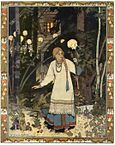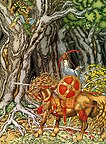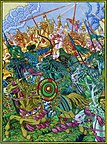art.wikisort.org - Artist
Ivan Yakovlevich Bilibin (Russian: Ива́н Я́ковлевич Били́бин, IPA: [ɪˈvan ˈjakəvlʲɪvʲɪt͡ɕ bʲɪˈlʲibʲɪn]; 16 August [O.S. 4 August] 1876 – 7 February 1942) was a Russian illustrator and stage designer who took part in the Mir iskusstva, contributed to the Ballets Russes, co-founded the Union of Russian Artists (Russian: Сою́з ру́сских худо́жников) and from 1937 was a member of the Artists' Union of the USSR. Ivan Bilibin gained popularity with his illustrations to Russian folk tales and Slavic folklore. His work was throughout his career inspired by the art and culture of Rus'.[1]

Biography
Ivan Bilibin was born in Tarkhovka, a suburb of St. Petersburg. He studied in 1898 at Anton Ažbe Art School in Munich, where he was heavily influenced by Art Nouveau and the German satirical journal Simplicissimus,[2] and then under Ilya Repin in St. Petersburg.[3] After graduating in May 1901 he went to Munich, where he completed his training with the painter Anton Ažbe.[citation needed]
In the period 1902 to 1904,[citation needed] working under the Russian Museum (Museum of His Imperial Majesty Alexander III) he traveled to the Vologda, Olonetsk and Arkhangelsk Governorates, performing ethnographic research, and examining examples of Russian wooden architecture.[4] He published his findings in the monograph Народное творчество русского Севера (Folk Arts of the Russian North) in 1904. Old Russian art had a great influence on his works. Another influence on his art was traditional Japanese prints and Renaissance woodcuts.[5][1]
After the formation of the artists' association Mir Iskusstva, where he was an active member, his entry into the newspaper and book graphics scene began with a commission for the design of magazine Mir Iskusstva in 1899, later contributing essays on Russian folk art.[6] Artistic design of other magazines such as Dog Rose (Шиповник) and productions of a Moscow publishing house followed. Bilibin gained renown in 1899, when he released his illustrations of Russian fairy tales. During the Russian Revolution of 1905, he drew revolutionary cartoons, especially for the magazine Zhupel (Жупелъ), which in 1906 became prohibited because of his illustration depicting the emperor as a donkey.[7] He served as the designer for the 1909 première production of Nikolai Rimsky-Korsakov's The Golden Cockerel.
In 1911, Bilibin was hired by the State Paper Manufacturing Section to illustrate ball programs, exhibition and book posters, postcards for the Red Cross's Society of St. Eugenia, and envelopes and stationery with the Russian Bogatyrs.[8]
After the October Revolution in 1917, Bilibin left Russia when the revolution proved alien to him. Hungry for a new exotic environment, in 1920 Bilibin went to stay in Egypt. He moved to Cairo and Alexandria where he painted for the Greek colony. In Cairo he specialized in the Byzantine-style art that was in demand by the Greek colony for icons and frescoes. He was also enraptured by the architecture of mosques and their "head-spinning ornamentation". Bilibin then settled in Paris in 1925, where he took to decorating private mansions and Orthodox churches.[3] He still longed for his homeland, and, after decorating the Soviet Embassy,[citation needed] he returned in 1936 to Soviet Russia. Bilibin died during the Siege of Leningrad, starving within the city when he refused to leave,[4] and was buried in a collective grave.

Marital life
In 1902 Bilibin married his former student, the Irish-Russian painter and illustrator of children's stories[9] Mary Chambers (Мария Яковлевна Чемберс). They had two sons, Alexander (1903) and Ivan (1908). In 1912 he again married a former student, the art school graduate Renée O'Connell (Рене Рудольфовна О'Коннель), granddaughter of Daniel O'Connell. In 1923 he married the painter Aleksandra Shchekatikhina-Pototskaya (Александра Васильевна Щекатихина-Потоцкая), with whom he had a joint exhibition in Amsterdam in 1929.
Publications
- Bilibin, Ivan (1904), Народное творчество русского Севера [Folk Arts of the Russian North] (in Russian)
- Folktales published by the "Department for the Production of State Documents"
- Сказка об Иване-царевиче, Жар-птице и о Сером волке [The Tale of Ivan the Tsar's Son, The Firebird and the Grey Wolf] (in Russian), [N.p.] Izdanie Ekspeditsii zagotovleniia gosudarstvennykh bumag, 1899 . alt link
- Василиса Прекрасная [Vassilisa the Beautiful] (in Russian), 1899
- Царевна-Лягушка [The Frog Princess] (in Russian), 1899
- Перышко Финиста Ясна-Сокола [The Feather of Finist the Falcon] (in Russian), 1900
- Марья Моревна [Maria Morevna] (in Russian), [N.p.] Izdanie Ekspeditsii zagotovleniia gosudarstvennykh' bumag, 1901
- Сестрица Аленушка и братец Иванушка [Sister Alenushka and Brother Ivanushka] (in Russian), 1901–1902
- Белая уточка [The Little White Duck] (in Russian), 1902
- Былина "Вольга" [The epic "Volga"] (in Russian), 1903 , pdf
- Collections in translated tales :
- Wheeler, Post, ed. (1917), Russian Wonder Tales , twelve selected illustrations
- Afanasyev, Alexander (1996), Russkie narodnye skazki - Russian Fairy Tales (in Russian and English) , selection from "State Department" work (1899-1902) that includes Sister Alionushka..; Tsarevich Ivan, the Firebird, and the Grey Wolf; The Frog Tsarevna; Vasilisa..; Feather of Finist; White Duck; and Maria Morevna. Main illustrations only
- Illustrations of Pushkin's tales
- Pushkin, Alexander (1834), Сказка о золотом петушке [The Tale of the Golden Cockerel] (in Russian)
- Pushkin, Alexander (1905) [1831], Сказка о царе Салтане [The Tale of Tsar Saltan] (in Russian)
- Pushkin, Alexander, Сказка о рыбаке и рыбке [The Tale of the Fisherman and the Fish] (in Russian) , unpublished
- Pushkin, Alexander, Руслан и Людмила [Ruslan and Ludmilla] (in Russian)
- Other
- Roslavlev, A.S. (1911), Сказки [Fairy Tales] (in Russian)
- Поди туда — не знаю куда, принеси то — не знаю что… [Go there - I do not know where, bring that - I do not know what ...] (in Russian), 1919 , unpublished
- Contes de l'Isba [Tales from a Hut] (in French), 1931
- Carpenter, Francis (1932–1933), Tales of a Russian Grandmother
- Contes de la couleuvre [Tales of the Snake] (in French), 1932
- Conte du petit poisson d'or [Tale of the little Golden Fish] (in French), 1933
- Le Tapis Volant [The Flying Carpet] (in French), 1924
- Le farouche Abd-el-Kader (in French), 1936
- Adhémar de Montgon. Henri IV (in French), 1936
- Anderson, H.C. (1937), The Little Mermaid (in Russian)
- Percheron, M. (1937), Moscou (in French)
- Tolstoy, A.N., Петр Первый [Peter the Great] (in Russian)
- Песнь про царя Ивана Васильевича, молодого опричника и удалого купца Ивана Калашникова [A song about Tsar Ivan Vasilyevich, a young oprichnik and the successful merchant Ivan Kalashnikov] (in Russian), 1939
- Vodovozov, N.V. (1940), Слово о стольном Киеве и о русских богатырях [Stories of the capital Kiev and Russian Heroes] (in Russian)
Gallery
- Baba Yaga from Vasilisa the Beautiful, 1899
- Vasilisa the Beautiful, 1899
- Ivan Tsarevich catching the Firebird's feather, 1899
- Sadko, 1902
- Illustration from Volga, 1904
- The Island of Buyan, 1905
- Ilya Muromets and Nightingale the Robber
- Dobrynya Nikitich rescues Zabava from the Gorynych, 1941
- The Tale of Igor's Campaign, 1941
- Koschei the Deathless (from Marya Morevna, 1900)
- Administering Justice in Kievan Rus, 1907
- Tsar Dadon meets the Shemakha tsarevna (illustration to The Tale of the Little Golden Cockerel, 1906)
References
- "The Art of Ivan Bilibin : Textualities". Retrieved 2019-10-07.
- Jose Alainz, Komiks: Comic Art in Russia, 2010, p.26
- Janina Orlov, 'Ivan Bilibin' in Donald Haase, The Greenwood Encyclopedia of Folktales and Fairy Tales: A-F, p.121
- Isaeva, Ksenia (16 Aug 2016), "Russian fairy tales in the works of Ivan Bilibin", www.rbth.com
- Maria Peitcheva, Ivan Bilibin: Drawings Colour Plates, 2016, p.1
- Richard Taruskin, 'From Subject to Style: Stravinsky and the Painters' in Jann Pasler, Confronting Stravinsky: Man, Musician, and Modernist, 1986, p.26
- Hardeman, Hilde (1987). "The Publishing-House Z. I. Grzhebin". Solanus. New Series. 1.
- Elena Litovchenko, 'Late Nineteenth Century Cover Designs from the Collection of the Research Museum of the Russian Academy of Fine Arts' in Alla Rosenfeld, Defining Russian Graphic Arts: From Diaghilev to Stalin, 1898-1934, p47-48
- Rosalind P. Blakesley, 'The Venerable Artist's Fiery Speeches Ringing in my Soul', in J.B Bullen, Internationalism and the Arts in Britain and Europe at the Fin de Siècle, p.101
External links
- Works of Ivan Bilibin at Cascadia Graphics
- Ivan Yakovlevich Bilibin at the Wayback Machine (archived December 2, 2005) at www.scumdog.demon.co.uk
На других языках
[de] Iwan Jakowlewitsch Bilibin
Iwan Jakowlewitsch Bilibin (russisch Иван Яковлевич Билибин; wiss. Transliteration Ivan Jakovlevič Bilibin; * 4. Augustjul. / 16. August 1876greg. im Dorf Tarchowka nahe Sankt Petersburg; † 7. Februar 1942 in Leningrad) war ein russischer bzw. sowjetischer Maler, Buchillustrator und Theaterschaffender. Er war Mitglied der Vereinigungen Mir Iskusstwa (Die Welt der Kunst), Mitbegründer des Sojus russkih hudožnikov (Vereinigung der russischen Maler) und ab 1937 Mitglied des Sojus hudožnikov SSSR (Malervereinigung der UdSSR).- [en] Ivan Bilibin
[es] Iván Bilibin
Iván Yákovlevich Bílibin (en ruso: Иван Яковлевич Билибин) (16 de agosto de 1876 - 7 de febrero de 1942) fue uno de los ilustradores más influyentes del siglo XX y diseñadores escénicos que tomó parte en el Mir iskusstva y contribuyó a los Ballets Rusos. A largo de su carrera, estuvo fuertemente inspirado por el folclore eslavo.[fr] Ivan Bilibine
Ivan Iakovlevitch Bilibine (Иван Яковлевич Билибин, 1876-1942) est un peintre russe, illustrateur de livres et décorateur de théâtre, membre de l’association Le Monde de l’Art (Mir iskousstva / Мир искусства).[it] Ivan Jakovlevič Bilibin
Ivan Jakovlevič Bilibin (in russo: Иван Яковлевич Билибин?; Tarchovka, 16 agosto 1876, 4 agosto del calendario giuliano[1] – Leningrado, 7 febbraio 1942) è stato un pittore e illustratore russo.[ru] Билибин, Иван Яковлевич
Ива́н Я́ковлевич Били́бин (4 [16] августа 1876, Тарховка, Санкт-Петербургская губерния — 7 февраля 1942, Ленинград) — русский художник, книжный иллюстратор и театральный оформитель, участник объединения «Мир искусства».Другой контент может иметь иную лицензию. Перед использованием материалов сайта WikiSort.org внимательно изучите правила лицензирования конкретных элементов наполнения сайта.
WikiSort.org - проект по пересортировке и дополнению контента Википедии











